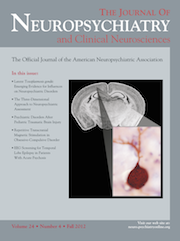Wernicke’s Encephalopathy Mimicking an Acute Psychotic Disorder
To the Editor: Wernicke’s encephalopathy (WE) is an acute reaction to thiamine deficiency, characterized by the classical triad of confusion, ataxia, and oculomotor abnormalities first described by Carl Wernicke in 1881. However, thiamine deficiency can also present with several neuropsychiatric signs and symptoms other than the classical triad. Moreover, cardiac beriberi, neuropathic beriberi, and, perhaps, gastrointestinal beriberi may occur.1 Here, we reported on a patient who presented with psychosis as presenting feature of WE.
Case Report
A 27-year-old woman developed a first episode of psychotic symptoms such as apathy, auditory, visual hallucinations, and persecutory delusions for 5 days. She had a previous personal history of alcohol dependence for the past 2 years. Her weight was 45 kg., with a body mass index of 15. Routine laboratory tests revealed negative findings, as was blood alcohol level. On admission, an initial diagnosis of acute psychotic disorder was made, and she was treated with olanzapine 10 mg nightly. On Day 7, she had diplopia and ataxic gait, whole-body trembling, choreic dyskinesia over perioral muscles, and numbness sensations over four extremities. A thorough neurological examination revealed decreased deep tendon reflexes and muscle strength symmetrically in all four limbs. Meanwhile, nerve conduction velocity showed sensorimotor peripheral polyneuropathy. Computed tomography (CT) of brain revealed a negative finding. More detailed laboratory analysis, including cobalamin and folic acid level, and thyroid function, all were within normal limits. WE was considered in the differential diagnosis, so the olanzapine was discontinued, and oral thiamine 300 mg daily was given on Day 10. On Day 12, auditory and visual hallucinations and persecutory delusions subsided. On Day 14, her diplopia and dyskinesia resolved. On Day 20, her motor coordination, numbness, and muscle weakness also improved. On Day 30, she was discharged and treated with thiamine 300 mg daily without relevant neuropsychiatric alterations for 1-month follow-up.
Discussion
The triad of classic WE is present in only approximately 16% of patients.
Furthermore, about 19% of patients have none of the symptoms of the classic triad at the presentation of WE.2 A previous report related to an adult psychotic patient with WE was associated with the classical triad initially.3 Our patient initially presented only psychotic symptoms, without prominent classical triad manifestations of WE until the 7th day after admission. Refeeding syndrome4 may suffice as the most clinical possible cause after the patient received 1 week of regular diet. Furthermore, dystonic hand tremor as a complication of WE5 had been reported, but choreic dyskinesia over perioral muscles is rarely reported. Also, a positive response to thiamine replacement supports the causal relationship between thiamine deficiency and psychotic symptoms. Little is known about the temporal progression of neuropsychiatric signs in WE, although usually one or more symptoms appear later in the course of the disease.
There were also some limitations in this report. First, the patient did not receive magnetic resonance imaging (MRI) for its better sensitivity in visualizing the possible occurrence of altered signal intensity in selective diencephalic and brainstem areas more commonly observed in WE than with CT.6 Second, blood thiamine level was not obtained, since WE is a consequence of thiamine deficiency, and thiamine may be an important adjunctive treatment in a complicated psychiatric patient with a clinical history indicative of WE.
1 : Myths and misconceptions of Wernicke’s encephalopathy: what every emergency physician should know. Ann Emerg Med 2007; 50:715–721Crossref, Medline, Google Scholar
2 : Clinical signs in the Wernicke-Korsakoff complex: a retrospective analysis of 131 cases diagnosed at necropsy. J Neurol Neurosurg Psychiatry 1986; 49:341–345Crossref, Medline, Google Scholar
3 : Acute psychotic disorder after gastric bypass surgery: differential diagnosis and treatment. Am J Psychiatry 2006; 163:15–19Crossref, Medline, Google Scholar
4 : Refeeding syndrome. BMJ 2004; 328:908–909Crossref, Medline, Google Scholar
5 : Dystonic hand tremor in a patient with Wernicke encephalopathy. Parkinsonism Relat Disord 2009; 15:479–481Crossref, Medline, Google Scholar
6 : Wernicke encephalopathy: MR findings and clinical presentation. Eur Radiol 2003; 13:1001–1009Medline, Google Scholar



